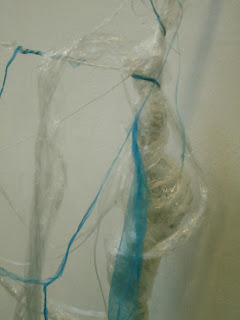 |
| Carole at Crate |
This photo was taken at Cratespace in Margate as part of the Come As You Go exhibition curated by Aine Belton, April 2013. The photographers were Vincci Huang and Holly Skinner, who combined views from Taiwan with images of visitors to the exhibition in Margate.
I make
extraordinary objects, incongruous organic forms that explore our relationship
with the natural world and how we experience it, experiments that challenge our
response to gravity, weight, fragility, ephemerality and the forms of nature.
I work with a range
of materials to create sculptural pieces and installations. I am inspired by
the forms of the natural world and use materials such as stones, ivy,
flowers and twigs to create my work. I also use plaster, clay, muslin, string
and wax and sometimes more unconventional materials: cling film, plastic
webbing and toilet tissue paper.
I am particularly
interested in the concepts of change and decay. As many
of my pieces are made from natural materials, such as vegetation, they
degenerate over time, changing their nature and metamorphosing into a different state. The leaves of the ivy wither, brown and curl, but in this process reveal
another aspect of their substance and suggest the passage of time.
My practice is
experimental and intuitive; my pieces evolve as a relationship between myself
and my materials. As I work I learn from the particular qualities of those
materials, which changes the course of the outcomes I produce.
There is a strong
element of craft in my work; I use the techniques of weaving, twisting, winding
and wrapping my materials to create different textural effects. As I weave with my material I am making hundreds of
small decisions: how tight the tension with which I pull the
thread, in which direction I manipulate it, to wind or wrap, to twist or fold,
how much to vary the thickness to create texture in the surface of the form.
The form evolves; a result of hand, eye, mind and material. The
resulting object holds a thousand memories of learning how to make it.
There are two
strands in my practice; as well as my studio work I have also worked on number
of community art projects, inviting members of the public to participate in a
community making event. Most recently I have run two workshops where people
have made a Stefani, a Greek flower garland made at Maytime to welcome the
spring and invite new love into their lives. As the participants wove their Stefani I
recorded their voices and invited them to weave messages into their garlands.
We displayed the Stefani to create an evolving communal art exhibition and the
workshop itself explored the experience and significance of communal making.












































